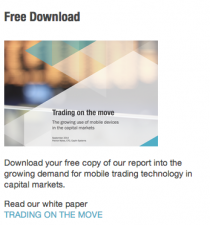The FX technology arms race continues unabated, with the top banks jockeying for position in the global FX rankings.
Leading banks in the global FX business are highly innovative, with a deep understanding of their clients risk management requirements. They also have the ‘luxury of large budgets’ and correspondingly large and talented in-house technical competence required to develop and deploy highly sophisticated functionality spanning the full trade life cycle from pre-trade, execution, through to rich post trade reporting tools targeted to specific client segments.
It’s also the case, that banks are providing these innovative risk management tools and services through their own client relationship channel, which is of course their single dealer platform.
The WSJ ran a story today (click on the link via Google) about banks delivering sophisticated trading tools to client. Amongst the latest armoury to be deployed are FX algorithms. Banks having used these internally to manage their own risk positions, are now exposing these tools to clients. Deutsche Bank is releasing a suite of algorithms to enable (sophisticated) clients to execute large trades with minimum market impact by time slicing the trades into smaller parcels, interacting directly with the bank’s own internal liquidity pool, or external markets. It’s interesting to note that Credit Suisse has for a long time offered such sophisticated algorithms to clients as part of their agency brokerage AES service.
So, at the top end of the market, we continue to see huge innovation, and massive spending but to what effect?
The latest BIS 2010 triennial survey result show, that global FX volumes are topping $4trillion a day level (driven by an 85% increase in volumes from ‘other financial institutions’ – hedge funds, high frequency shops, client banks and the growing retail broker segment).
Yet, according to the EuroMoney 2011 FX poll, the share of the top 3 banks (Deutsche, Barclays and UBS) has actually fallen in the past two years down from 46% in 2009 to 37%. It seems that the top tier banks can’t innovate fast enough to maintain their share of the growing pie.
Then who is winning, and why?
Paul Caplin explains this in the 4th of his series of articles on how single dealer platforms are evolving.
We are seeing the democratisation of trading technology, with a growing number of tier 2 banks embarking on their own single dealer platform projects. But rather than build the entire platform, these institutions are leveraging new single dealer platform frameworks, giving them a head start, and enabling them to focus their available budgets and expertise where it adds the most value, which is on adding the client specific functionality required to protect, and grow their own client franchise – as highlighted in last year in my coverage of the 2010 EuroMoney FX survey results.
So, what’s in store moving forward?
According to the EuroMoney 2011 FX survey, the 6th to 10th placed banks increased their share from just over 22% to 25%.
I have a feeling that despite top banks continuing to invest heavily in an effort to innovate and maintain their market share, that we will see an increasing number of banks lower down the rankings, investing in newer next generation single dealer platforms to defend and grow their own client relationships, and I would not be surprised to see the top banks continue to lose market share to regional banks who invest in their own client relationship channels.
Filed under: BIS, FX, Single-Dealer Platforms, Survey Results | Tagged: BIS, Euromoney, FX, Ranking, SDP |



[…] Bank’s are upping their game: Global bank’s in the lower part of the table, are all ‘upping their game’, investing in new SDPs, and eroding the market share of the top flow banks. This is being reflected in greater attention to design and UX of their SDPs and as the awards below show, these efforts are paying off. More coverage on rankings and churn here and here […]
[…] has seen a migration of “e” talent from top-tier to regional banks, resulting in those top FX banks losing market share to regional banks who have upped their game and enhanced their own […]
[…] In many cases, we also see migration of ‘top e-trading’ talent moving to regional banks to provide expertise in managing new SDP projects as mentioned in recent posts here and here. […]
[…] The chart below is very interesting, as it shows the change in market share of each of the bank groups from the above chart. As can be seen, the top-tier global ‘flow monsters’ have been investing hugely in their platforms, yet they have lost market share. The big winners being the regional banks, growing market share at a fraction of the cost. […]